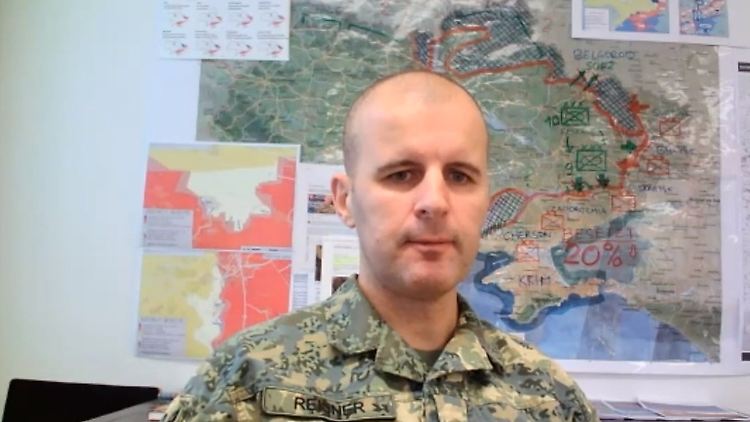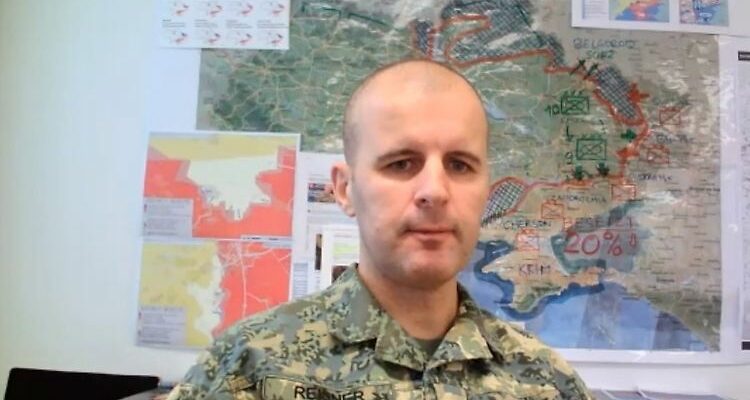Ukraine and Russia are engaged in trench warfare, but if things go a few meters ahead, then it will be for Putin’s troops. How do they manage this when drones are constantly and everywhere reconnoitering the battlefield? Colonel Reisner provides answers at ntv.de.
ntv.de: Mr. Reisner, what does the front in Ukraine currently look like?
Markus Reisner: We are currently seeing attacks along the entire front and – despite high losses – also successful incursions and, in some cases, local breakthroughs by the Russians. In the area southeast of Kupyansk, it was possible to break five kilometers deep into the Ukrainian defensive positions near Tabaivka. The aim here is apparently to reach the Oskil River and take possession of the entire area east of it. The Russian troops also advanced a kilometer further south, near Terny, before the attack was stopped. We also see heavy fighting in the Svatove, Lyman, Bakhmut and Marjinka regions. The Ukrainians had gained ground near Bakhmut during the summer offensive, and the Russians are now taking it back, meter by meter. At Avdiivka the Russians gained space north and south of the city.
First-person view drones, i.e. drones equipped with cameras that give the soldier a direct view of the battlefield as if he were sitting inside the device, are currently having a strong effect on the battlefield. Both sides survey the battlefield so closely that neither can create an element of surprise. Why can the Russians still gain territory?
If we look at the battlefield near Avdiivka as an example: the Russians won the area south of the city by apparently using an underground tunnel. Through this they got behind the Ukrainian positions and were then able to surprise the Ukrainians from there.
What about the other sectors of the front where the Russians are successful? How do they manage it there?
As far as available soldiers are concerned, we currently have a certain parity at the front, so the situation is balanced. However, the Ukrainians are at a massive disadvantage when it comes to available ammunition – for artillery, but also for main battle tanks and anti-aircraft systems. This is what Ukraine needs on the front lines to at least keep the Russians at a distance. The more supplies there are reduced, the easier it is for the Russians to gain the upper hand – despite the heavy losses they incur in the process. But we have already recognized that human losses, i.e. soldiers’ lives, are not a parameter for the Russians – no reason to base their attacks on them in any way.
How do you act as a Russian commander on the battlefield when the rule from Moscow is: “You don’t have to take human life into account”?
There are a lot of videos circulating on the internet, produced daily by both sides, to show their respective attacking or defensive successes. I can deduce a lot from these films when I look at the Russian operational leadership there. At the beginning, the Russians made massive use of artillery and kamikaze drones and sent troops forward in a first wave. These soldiers walk straight into the fire of the Ukrainians. This approach serves primarily to identify the Ukrainian positions. Then there is more artillery, another kamikaze drone and finally a second wave of fresh soldiers attacks massively. This is how the Russians gain ground and advance, meter by meter.

Markus Reisner is a colonel in the Austrian armed forces. Every Monday he analyzes the war situation in Ukraine for ntv.de.
In other words, are the Russians sending in troops that have no function other than to be targets for the Ukrainian defenders? And when the Ukrainians shoot down these Russian soldiers, you can see where they are firing from, and the Russians know: Aha, there is a Ukrainian position there. That’s the tactic?
Exactly. The videos also show that the Russians tend to use subordinate units in these initial attacks. Troops that are heavily populated with reservists have poorer training. They are pure cannon fodder. In the next phase, these identified Ukrainian defensive positions will be targeted before a new attack occurs, a second wave. It can be seen here that the soldiers are much better trained than those in the first wave. By the way, this is reminiscent of the tactics of the Soviet Army in the Second World War: Back then, poorly trained soldiers were often sent forward as cannon fodder so that the German side would use up ammunition for defense and reduce stocks. Only then did the elite attack. This element of the military culture of the Russian armed forces has been preserved from the Soviet era.
How is Ukraine responding to defend the site despite running out of ammunition?
We are currently watching how the Ukrainian side is creating reserves, and here the deployment of the Seventh Air Assault Corps stands out. This is obviously an attempt to create deployable reserve units at the operational level. These troops act as a kind of front-line fire brigade that is quickly available when needed to counter the attacking Russians.
If we go back to the great importance of drones: What are the conditions there now? Can Ukraine catch up with Russia?
Russia’s industry, especially in a war economy, is significantly more efficient than that of Ukraine. Moscow aims to produce 100,000 kamikaze drones per month. Thanks to the support of the global south, such as China, Russia has a good chance of achieving its goal. Kiev aims to produce 50,000 kamikaze drones per month this year.
50,000 drones – but that sounds like industrial production, no longer like tinkering in the backyard like it did months ago?
On the one hand, Ukraine is producing drones that can fly deep into Russia. The number of units produced is still relatively small. On the other hand, the small first-person view or kamikaze drones that currently dominate the battlefield come from 3D printers. They can be produced quickly with prefabricated components and are already being used by Ukraine as a replacement for the missing artillery shells. Kiev is ramping up production in the military production facilities that already exist and at the same time is calling on the population to help. Every Ukrainian should try to produce and deliver a drone in their own home so that it can be used at the front. You can download construction plans from the Internet. So a lot is being done, but compared to Russia’s resources it still sounds rather provisional.
A word about Russia’s resources: Can Moscow expand them so massively, despite Western sanctions?
Look at Iran, a country that suffers from a very strict sanctions regime. Nevertheless, it was able to develop into a drone superpower and sends its drones to support the Houthis, supplies Hamas with components, sends them to Hezbollah in southern Lebanon and supports Russia on a large scale. The Russians have now also set up their own drone factory, the target is 300 to 350 units per month. As far as we know, many of the necessary components come from China, but some, and this is really sobering, also find their way to Russia from Europe. Via subcontractors or rat lines.
Rat lines?
Ways on which valuable goods are transported from A to B behind the backs of existing sanctions. For example, about third countries that are not sanctioned. If we take oil as an example: India buys oil in Russia, loads it onto its tankers, which go to the Mediterranean. There it is reloaded onto other tankers and sent to Europe, for example. North Korea, another example, sent Russia a million artillery shells last year. Satellite images show the material being transported to Russia on North Korean ships or trains.
The West always discusses possible arms deliveries against the background of the time required, i.e. how many months or even years it would take until newly produced battle tanks or anti-aircraft systems would be available to Ukraine. In contrast, drones should be able to be produced using a 3D printer in no time. Where are the Western supplies?
You must not forget: the Russian war economy produces on command. The European defense industry is structured and organized primarily on a private sector basis. The companies only produce if there are purchase commitments, i.e. if money is sure to flow. Accordingly, governments should ask the defense industry: What capacities do you have and what could we do together? But that doesn’t happen. There are commitments and orders, but not to the extent that it would really make a difference compared to what Russia, North Korea or others are doing in the meantime. The situation is similar with cruise missiles: It is assumed that Russia currently has around 900 cruise missiles available and the production rate is already 115 to 130 per month.
While Germany has been discussing for eight months now whether to send 150 Taurus cruise missiles to Ukraine as a one-off. How does Russia use its resources?
They have the opportunity to carry out a massive attack approximately every ten to 14 days, in which the air defense is saturated by Iranian drones and the cruise missiles can then penetrate. If, for example, the Ukrainian anti-aircraft defense can shoot down eight of ten missiles, two will still get through and hit the target. The air defense system that is used here to protect the infrastructure against such attacks is also missing at the front. New videos come from there every day showing Russian warplanes attacking Ukrainian positions with glide bombs. Here Ukraine hardly has any systems to defend itself because the front is so long and the country is so big. Hence the massive demands in this direction again and again. A war of attrition is decided primarily by resources.
Frauke Niemeyer spoke to Markus Reisner
